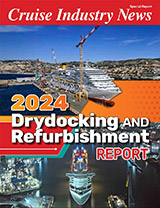Bondholders have taken control of Premier Cruises as part of a recapitalization plan which creates a financial “firewall” between Premier’s operations and the oppressive debt load of its $160 million bond offering. The deal also allows for a new $55 million loan either arranged or directly provided by Donaldson Lufkin & Jenrette (DLJ) at an interest rate of between 11 and 14 percent, which repays the $34 million loan DLJ gave Premier in July and adds $21 million in working capital.
The restructuring has created two distinct companies, a new operating company, also called Premier Cruises, and the original entity, which now serves as a holding company. The holding company is responsible for the remaining $151.2 million in debt stemming from the March 1998 DLJ-led bond offering. The new operating company possesses all Premier assets, including the six-ship fleet, and is responsible for operating expenses plus the servicing of the new $55 million loan (all six ships are now encumbered with first-priority liens securing this financing). Whatever money is left over after financing and operational obligations are met is handed over to the holding company as a dividend. The holding company then pays back what it can of the bond debt. If the $17.6 million annual obligation cannot be met, there is no longer an automatic default – alternative financial arrangements can be made.
The new deal dilutes the position of original shareholders to 35 percent, and gives bondholders 65 percent of the company and three of five votes on the board of directors. The bondholders would take over the remaining 35 percent if Premier does not perform.
With this recapitalization, the operating company can continue its turnaround efforts with greater flexibility than was allowed by the bond covenants. And it has now become far more unlikely that bondholders will place Premier into bankruptcy: doing so would leave bondholders with nothing save the profits from a six-ship firesale minus the total already committed to the lien-holder. In terms of the other two bankruptcy threats – the failure to cover operating expenses and the failure to service the new financing – neither appear imminent given the new cash cushion and the approach of the winter wave season, and both would be avoided in the long term if bondholders put in more money to protect their positions.
According to Premier COO Jon Erik Nygaard, the main impetus behind the new plan was the travel community’s crisis of confidence in Premier Cruises, which he admitted “had begun to affect our sales.”
From a confidence perspective, the recapitalization plan could not have come sooner for Premier – Standard & Poors (S&P) had just lowered Premier’s bond rating yet again, citing “lack of liquidity and limited financial flexibility,” and Premier’s third-quarter results are expected to fall short of expectations. Admitted Nygaard, “The third-quarter EBITDA will be less than (the projected) $10 million, for two reasons: one, the lack of confidence has complicated our bookings, and two, a recapitalization plan like this costs money.
“But this is a turnaround year. I think we all understand that, and our target EBITDA of $40 million for 1999 remains unchanged.”
Queried travel agents and financial analysts both expressed a positive short-term outlook on Premier following its recapitalization – although long-term forecasts remain unclear, and skepticism persists about Premier’s $40 million target for 1999.
According to Peter Kowal, general manager of Cruise Holidays, “We have been cautious in selling Premier for the fourth quarter. Our agents were frightened of the bankruptcy prospect, and if clients were interested in Premier, our agents told them about the financial problems first, then let the clients make an informed decision. I self-servingly want Premier to do well, because we benefit when there are alternatives to the big lines, but I don’t want our agents caught with their pants down in a Regency situation.” While favorable to news of the recapitalization, he asked, “What is the next hurdle?”
While member agencies of The Travel Company are taking the precaution of suggesting customers use credit cards to pay for Premier’s cruises, CEO Joe Vittoria asserted, “We’re certainly not discouraging sales of Premier, and we’re comfortable with the plan the company has just announced. We’re very anxious for them to stay around, because there is a niche for older classic ships.”
Financial analyst John Maxwell, who covers Premier for SG Cowen Securities, concluded, “In the short term, this recapitalization gives Premier time to see if it can execute its 1999 business plan, and I believe that if this (deal) didn’t happen, there probably wouldn’t be any 1999. In the long term, the plan essentially adds another $21 million in debt, and there is still a question of Premier’s ability to execute its plan. There will be increased capacity from competitors in 1999 as well as the possibility of a recession, so there are obviously some uncertainties ahead.”




